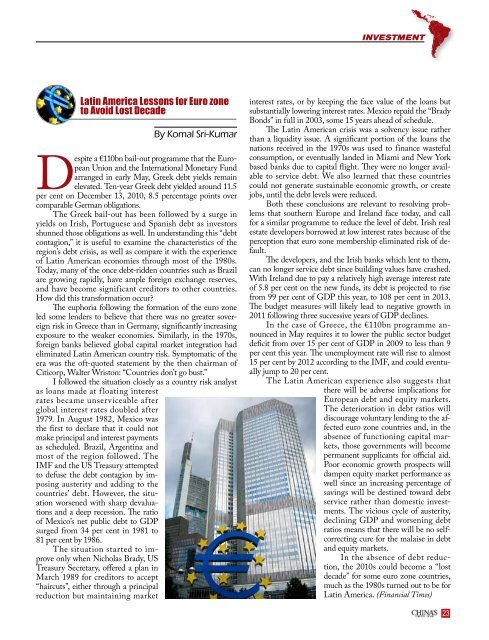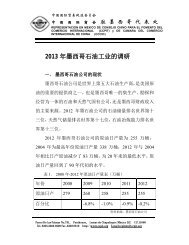You also want an ePaper? Increase the reach of your titles
YUMPU automatically turns print PDFs into web optimized ePapers that Google loves.
INVESTMENT<br />
Latin America Lessons for Euro zone<br />
to Avoid Lost Decade<br />
By Komal Sri-Kumar<br />
Despite a €110bn bail-out programme that the European<br />
Union and the International Monetary Fund<br />
arranged in early May, Greek debt yields remain<br />
elevated. Ten-year Greek debt yielded around 11.5<br />
per cent on December 13, 2010, 8.5 percentage points over<br />
comparable German obligations.<br />
The Greek bail-out has been followed by a surge in<br />
yields on Irish, Portuguese and Spanish debt as investors<br />
shunned those obligations as well. In understanding this “debt<br />
contagion,” it is useful to examine the characteristics of the<br />
region’s debt crisis, as well as compare it with the experience<br />
of Latin American economies through most of the 1980s.<br />
Today, many of the once debt-ridden countries such as Brazil<br />
are growing rapidly, have ample foreign exchange reserves,<br />
and have become significant creditors to other countries.<br />
How did this transformation occur?<br />
The euphoria following the formation of the euro zone<br />
led some lenders to believe that there was no greater sovereign<br />
risk in Greece than in Germany, significantly increasing<br />
exposure to the weaker economies. Similarly, in the 1970s,<br />
foreign banks believed global capital market integration had<br />
eliminated Latin American country risk. Symptomatic of the<br />
era was the oft-quoted statement by the then chairman of<br />
Citicorp, Walter Wriston: “Countries don’t go bust.”<br />
I followed the situation closely as a country risk analyst<br />
as loans made at f loating interest<br />
rates became unserviceable after<br />
global interest rates doubled after<br />
1979. In August 1982, Mexico was<br />
the first to declare that it could not<br />
make principal and interest payments<br />
as scheduled. Brazil, Argentina and<br />
most of the region followed. The<br />
IMF and the US Treasury attempted<br />
to defuse the debt contagion by imposing<br />
austerity and adding to the<br />
countries’ debt. However, the situation<br />
worsened with sharp devaluations<br />
and a deep recession. The ratio<br />
of Mexico’s net public debt to GDP<br />
surged from 34 per cent in 1981 to<br />
81 per cent by 1986.<br />
The situation started to improve<br />
only when Nicholas Brady, US<br />
Treasury Secretary, offered a plan in<br />
March 1989 for creditors to accept<br />
“haircuts”, either through a principal<br />
reduction but maintaining market<br />
interest rates, or by keeping the face value of the loans but<br />
substantially lowering interest rates. Mexico repaid the “Brady<br />
Bonds” in full in 2003, some 15 years ahead of schedule.<br />
The Latin American crisis was a solvency issue rather<br />
than a liquidity issue. A significant portion of the loans the<br />
nations received in the 1970s was used to finance wasteful<br />
consumption, or eventually landed in Miami and New York<br />
based banks due to capital flight. They were no longer available<br />
to service debt. We also learned that these countries<br />
could not generate sustainable economic growth, or create<br />
jobs, until the debt levels were reduced.<br />
Both these conclusions are relevant to resolving problems<br />
that southern Europe and Ireland face today, and call<br />
for a similar programme to reduce the level of debt. Irish real<br />
estate developers borrowed at low interest rates because of the<br />
perception that euro zone membership eliminated risk of default.<br />
The developers, and the Irish banks which lent to them,<br />
can no longer service debt since building values have crashed.<br />
With Ireland due to pay a relatively high average interest rate<br />
of 5.8 per cent on the new funds, its debt is projected to rise<br />
from 99 per cent of GDP this year, to 108 per cent in 2013.<br />
The budget measures will likely lead to negative growth in<br />
2011 following three successive years of GDP declines.<br />
In the case of Greece, the €110bn programme announced<br />
in May requires it to lower the public sector budget<br />
deficit from over 15 per cent of GDP in 2009 to less than 9<br />
per cent this year. The unemployment rate will rise to almost<br />
15 per cent by 2012 according to the IMF, and could eventually<br />
jump to 20 per cent.<br />
The Latin American experience also suggests that<br />
there will be adverse implications for<br />
European debt and equity markets.<br />
The deterioration in debt ratios will<br />
discourage voluntary lending to the affected<br />
euro zone countries and, in the<br />
absence of functioning capital markets,<br />
those governments will become<br />
permanent supplicants for official aid.<br />
Poor economic growth prospects will<br />
dampen equity market performance as<br />
well since an increasing percentage of<br />
savings will be destined toward debt<br />
service rather than domestic investments.<br />
The vicious cycle of austerity,<br />
declining GDP and worsening debt<br />
ratios means that there will be no selfcorrecting<br />
cure for the malaise in debt<br />
and equity markets.<br />
In the absence of debt reduction,<br />
the 2010s could become a “lost<br />
decade” for some euro zone countries,<br />
much as the 1980s turned out to be for<br />
Latin America. (Financial Times)<br />
23

















